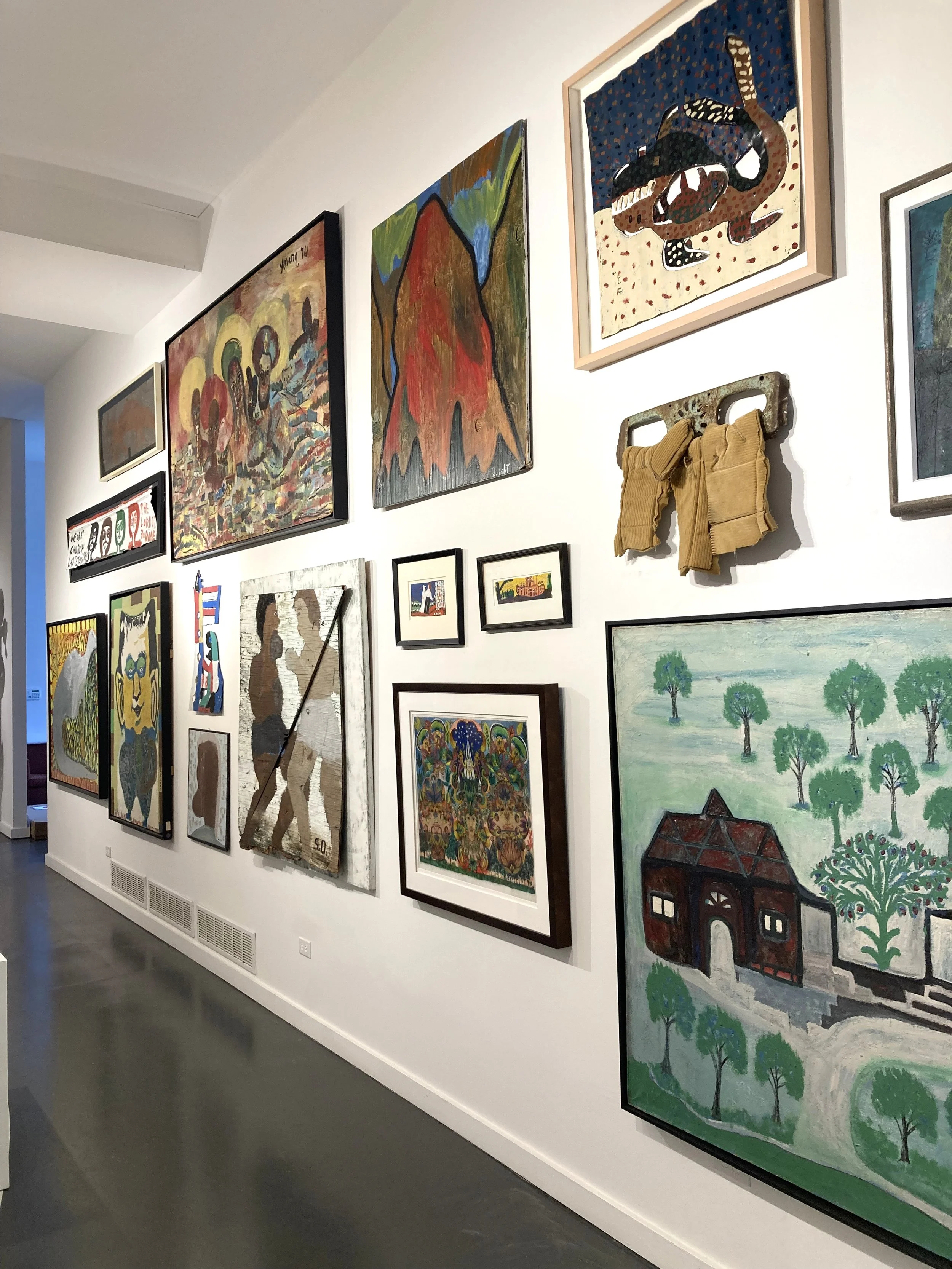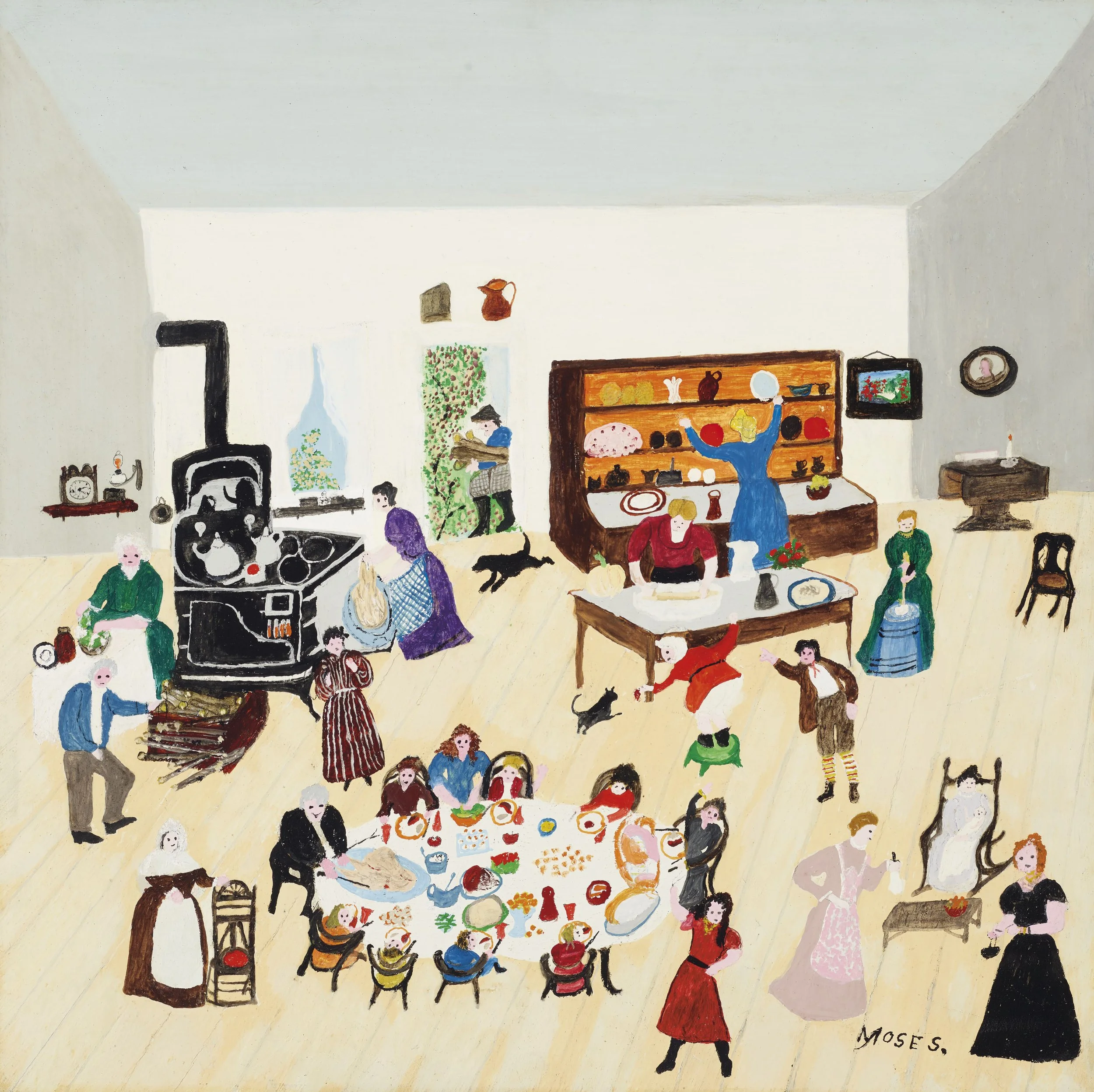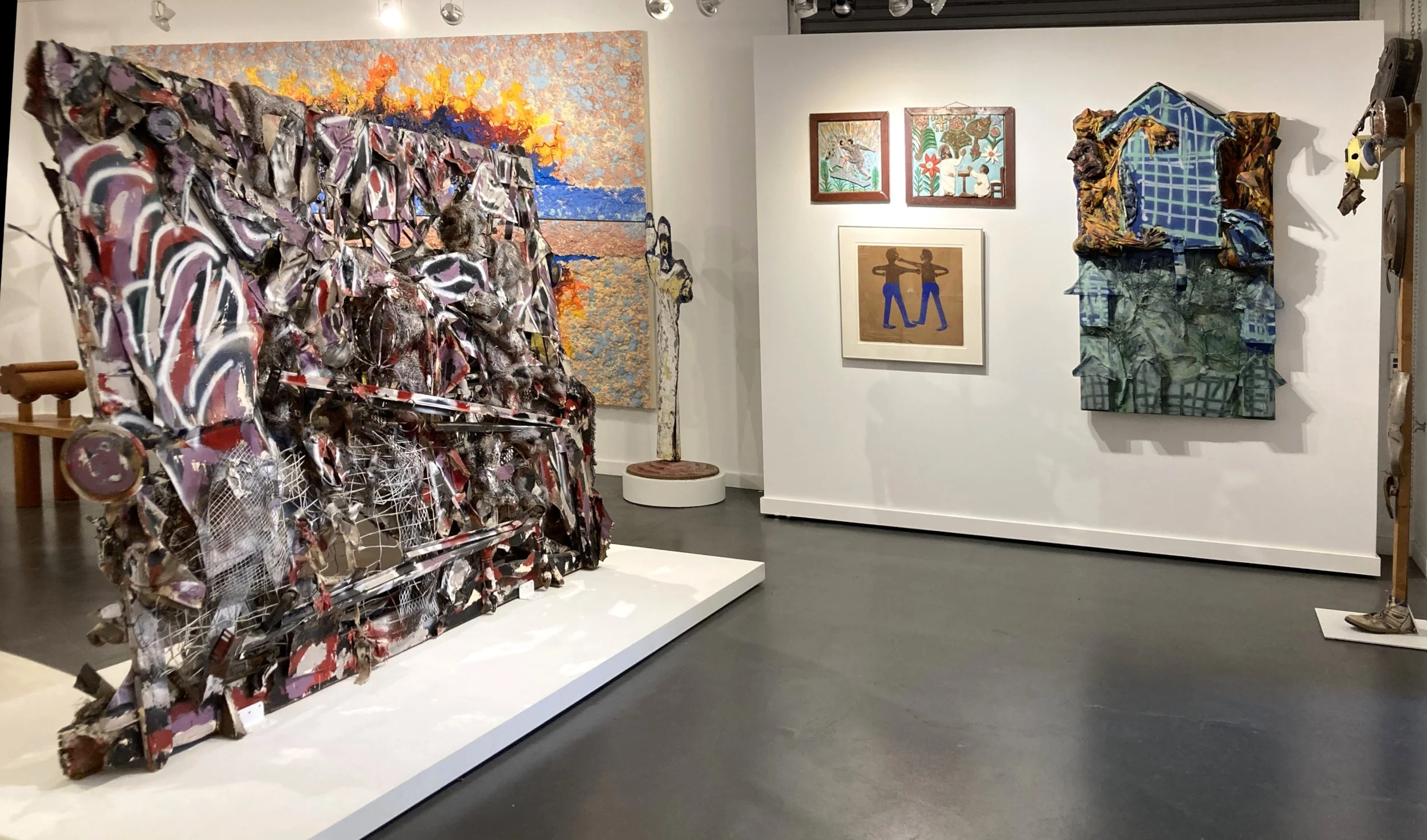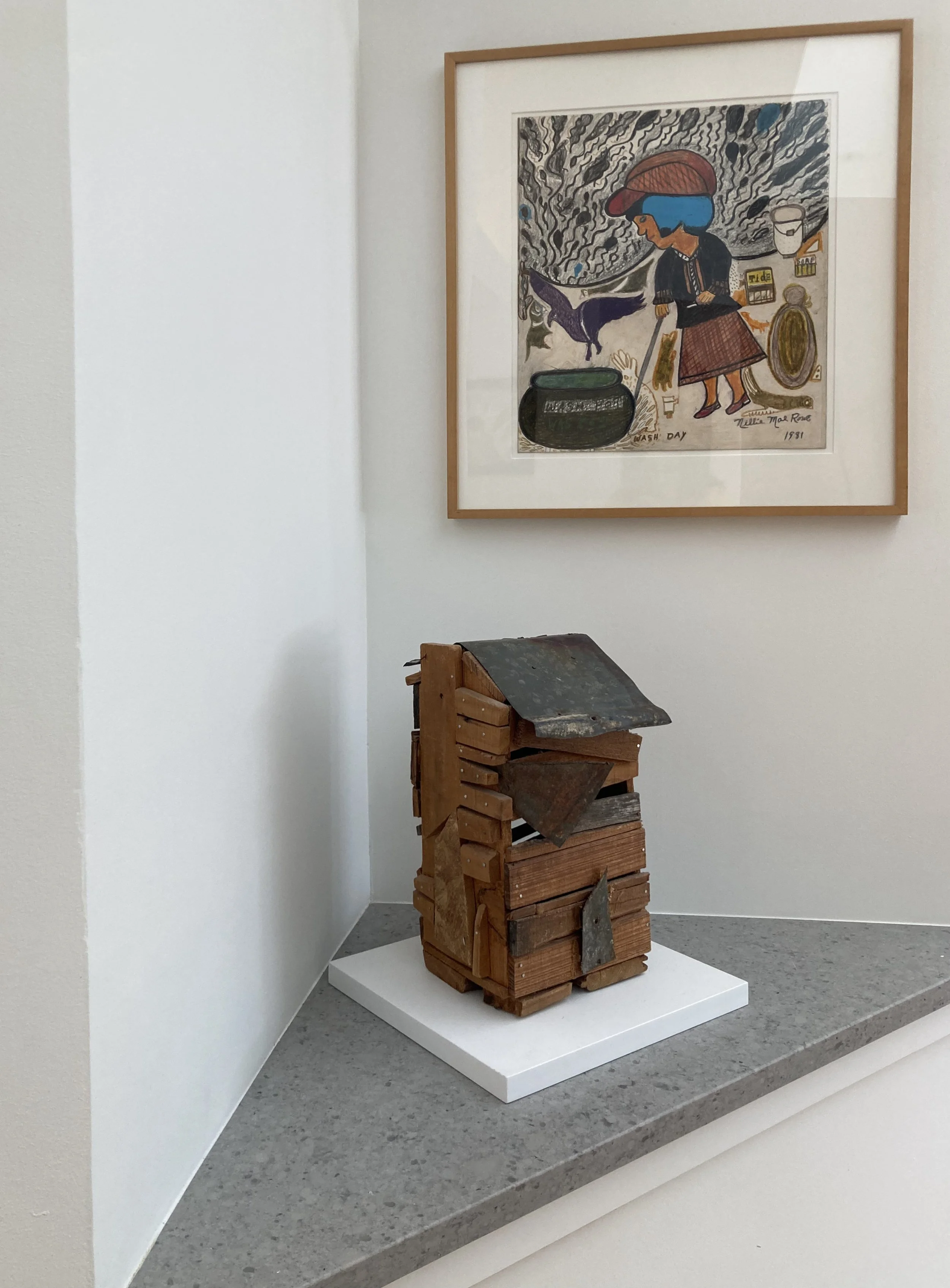JOHN HORSEMAN, ST LOUIS – MEET THE COLLECTOR PART SEVENTY TWO
On a trip to St. Louis for the opening of Shinichi Sawada’s ‘Agents of Clay’ exhibition, I was introduced by my friend and another collector John Foster, to a wonderful collector John Horseman and Anastasia Kinigopoulo, who is the director and curator of the Horseman Foundation. I saw two sites where much of his collection was housed and learnt that his collecting of outsider and self-taught art began only around a year ago, but his wider art collecting has been going on much longer. He and his wife Susan set up The Horseman Foundation in 2012, which is committed to expanding the knowledge and appreciation of 20th and 21st century American art. The private collection features paintings, sculptures, and drawings by artists historically left out of the canon, with major strengths in post-war paintings and sculptures by Black and Native American artists. Read on to find out more from John, his background, his collection, and the importance of access to it for part seventy two of my Meet the Collector series…
John Horeseman (right) with fellow collector John Foster and an angel by William Edmonson
Jennifer: What is your background?
John: For about forty years, I was a money manager. I owned a money management firm—an investment firm—until I sold it a couple of years ago to a larger one.
Jennifer: And now you are retired?
John: Well, I invest. I’m also the President of the St. Louis Art Museum Board of Commissioners. I enjoy making a contribution, and it gives me something to do. I spend a lot of time with our art collection – thinking about it and trying to decide what to do next. You know how art collectors are—always looking, analysing, and so on.
Jennifer: I think you do that more than most John. It’s not a bad thing!
John: I look at art every day! Obviously, I don’t buy something every day, but I look at things to buy every day!
Jennifer: It’s a nice luxury to have John. Was there someone early on that acted as a mentor for when you started to collect art?
John: I’ve had many mentors, both art dealers and museum curators. I learned a lot, and I’m so grateful for the amount of time folks were willing to spend with me. In particular, my friend Kevin Sharp, who is the director of the Dixon Gallery & Gardens in Memphis—I can’t even think of the countless hours and hours and hours we have spent chatting. Melissa Wolfe is the Curator of American Art here at the St. Louis Art Museum, and I’m sure my constant questions drove her up the wall. My friend Andy Walker, the director of the Amon Carter, practically screens my calls now, I think. So many dealer friends have helped me over the years: Garth Greenan, Thom Pegg, James Trotta-Bono, Andrew Edlin, Scott Kerr, Christine Berry, Corrine Cain, and Duff Lindsay. Artists, especially James Little and Tony Abeyta, have also been incredible inspirations. If you add it all up, I’ve probably spent years talking about art and about what to look for with these people.
Jennifer: At what point would you say, started collecting overall? How many years ago was that?
John: Seriously collecting, about twenty years ago.
Jennifer: And why?
John: Well, my wife Susan would say it’s because I couldn’t coach Little League anymore! I don’t have a background in art, and there was no family involvement in art. I’m sure that I was in the school bus that went to the Cleveland Museum of Art when I was in elementary school, although I don’t recall that. I had never gone into an art museum or a gallery until I was in my forties, and then it was just like – boom. An instant attraction.
Jennifer: It happened overnight?
John: Well, my background and my education is in economic and political history, and I’ve always been enamoured of the period between the wars—World War I and II—as well as the Cold War… that whole middle period of American history. And so, that was the art that we were initially drawn to. I think that art is like a book, it tells stories. Because that era was an interest of mine anyway, I was very much drawn to what’s sometimes referred to as Depression era art. And then the fifties, that unsettled, almost dark time, in our country and in the world, I suppose I was drawn to for the same reason. There was more to it—there was a resonance—to the social and political situations going on at that time.
Installation photograph from inside one of John’s collection buildings
Jennifer: What was the first piece of art you ever bought?
John: We actually still have it. It’s an American Impressionist painting called Bedtime Stories by an artist named Alice Beach Winter. It depicts a mother with her child, and the mom is telling a story to her daughter next to a fireplace. The figures are lit with this beautiful glow from the fire.
Jennifer: And does it hang in your home or does it hang in one of the buildings that people can visit?
John: It actually hangs in our home in Phoenix, Arizona.
Jennifer: And at what point is there a distinction between what goes into your home, and what goes into the buildings that people can visit?
John: From our initial collection, we kept some paintings that we both really liked, and most of those are in our homes. Let me tell you how we stumbled into self-taught art. My wife and I were driving from Saint Louis to Cleveland, and stopped in a gallery in Columbus, Ohio, which is on the way. And we went into a gallery in Columbus to look for a regionalist painting by an artist named Clarence Carter. While doing this, we saw a relief carving by Elijah Pierce. We had no idea who he was, but we fell in love with the work and acquired it, not knowing what it would eventually lead us into. That work is called Christ with Rose of Sharon and still hangs in our home.
My wife Susan is also a big fan of Grandma Moses’s work. I was a reluctant convert to Grandma Moses. So we acquired a Grandma Moses work from Christies that also hangs in our home. When we acquired these pieces, we weren’t making the distinction that they were works of self-taught art. They were just artworks we loved and owned.
Elijah Pierce, Bill Traylor, Thornton Dial
Jennifer: When you first started collecting, you said it was very focused on African American artists and you’ve got a lot of American art – why that in particular?
John: Well, we had been collecting American Regionalism and Modernism for about fifteen years when I was visiting a gallery with a curator, Andy Walker, who is now the director of the Amon Carter Museum. I saw this beautiful abstract painting that I found to be striking… it just hit me. We didn’t have any abstract works, and it was an Abstract Expressionist piece by an artist named Norman Lewis. I had no idea who Norman Lewis was, and Andy said that it was a really great painting that I should think about getting. So, I decided to do that. I found out more about who Norman Lewis was – he was an African American artist, probably the most important African American Abstract Expressionist painter.
There’s a very significant book about Abstract Expressionist (Ab Ex) painters by Irving Sandler. It enumerates the greatest Ab Ex painters of the 50’s and 60’s. Every one of the people in that book are white men with the exception of one white woman – Hedda Sterne. All the greats--Jackson Pollock, Robert Motherwell, Mark Rothko, so on. Certainly, you can’t argue with the selections, but the issue is who is left out—Norman Lewis. He was respected by all the other artists, he exhibited with them, and you see him in numerous photos with the group. I realized there was only one reason that Norman Lewis wasn’t in that book: he was Black.
I’m seventy years old, and everyone my age was taught that, yes, there was slavery and, yes, there was oppression, but after the Civil War, the slaves were freed and that was kind of the end of it. The evil and the terror of Jim Crow was just passed over in our schooling. My eyes were opened. It was obvious that if this could happen to Norman Lewis in the New York art world, then systemic racism was rampant in society and business everywhere. Art is a great teacher. This led my wife and I to completely recalibrate our collecting focus. We dispersed most of our collection, and began to acquire significant works by important Black artists of the 50s, 60s, and 70s.
As we continued to expand our African American collection, I acquired an important work by Beverly Buchanan from Andrew Edlin. He told me that I should take some time to learn about African American vernacular art. He suggested that I read Bill Arnett’s book about the Souls Grown Deep artists. I had also seen the Thornton Dial works at the Met. It was obvious to me as a collector of mainstream African American art that these vernacular works had to be a critical part of the collection. As I read about artists like Dial, William Edmondson, Bill Traylor, Purvis Young, and William Hawkins I realized that the work was just as meaningful even though they took a different path. Learning about self-taught art was truly a lightbulb moment for me. Seeing the abstraction of Norman Lewis and Thornton Dial side by side, you immediately understand that the talent and the inspiration are there regardless of whether an artist attended art school. I see the vernacular as just as worthy as work created by any trained artist.
I want to highlight the many people who have helped me on my journey to self-taught art. I mentioned Andrew Edlin, about whom I can’t say enough good things. Early on I met Duff Lindsay and John Foster, who have been patient listeners. Frank Maresca has been incredibly helpful. And John Jerit has allotted me untold hours of his valuable time. I owe my thanks to all of them. I think many of these artists will not be pigeon-holed as so-called folk artists, but will cross over into the realm of mainstream art as more contemporary collectors see and appreciate the work.
Grandma Moses, Thanksgiving
Jennifer: But, given what you’ve just said, if there’s someone considered as a folk artist and you’ve got them as part of your collection and you open up your collection for museum curators to look at, isn’t it important that they see the work of these folk artists to try and breakdown the fact that we’re trying to help them cross over and be seen more widely, and by seeing it in a collection like yours, don’t you think that then helps them look at it in a different way? I think it’s important that the lesser-known artists are profiled too.
John: Well, I was very fortunate to have been able to acquire William Edmondson’s Abstract Angel. We have that positioned in a room in our art space next works by Jack Whitten, Beverley Buchanan, and Noah Purifoy. It’s important to see that piece in context with these other artists. Take Purifoy, who was a trained artist and part of the LA assemblage group, using found materials and building artworks from those materials. Thornton Dial was doing something very similar. They would have never had any contact whatsoever, but both of them were motivated by the same drive—'I have to create, I’m going to take what’s around me to create’—and that’s what they did. That intuitive ability—to create and see the world around you and make something with that vision—it’s all the same whether they went to art school or not.
Jennifer: And so, with your collection, when did you decide to set up the Foundation and why?
John: I set that up in 2012. It gave us an opportunity to promote American art and to make a positive contribution to the art world in our own small way.
Jennifer: And at what point did you then did you feel you needed to bring a curator onboard to oversee what was going on?
John: I’ve had somebody helping me with that for a long, long time, probably almost from the get-go. Initially it was more of an administrative role. Then with Anastasia, who also directs the Foundation, it’s a full-blown curatorial position.
Jennifer: It’s so good that you had someone, not only Anastasia now, but that you had someone doing that admin side because if you speak to other collectors, they don’t have the level of detail that you have, and some are going back to try and find that information out now from pieces bought years ago. So, Anastasia, you work full time?
Anastasia: Oh, absolutely. So, the Foundation is the non-profit side of the collection. Our mission, broadly, is to expand the canon of American art. This is a certainly a conversation that John and Susan have been part of long before I came along. And when they started collecting, that conversation included regionalism. It’s hard to believe now, but twenty years ago, most forms of 20th century figurative art were not taken very seriously in this country—certainly not as forms of modernism. Since I’ve been working with John and Susan in this capacity, the focus has been on African American artists and Native American artists, and now vernacular art is part of that scope, as well.
Vernacular art is particularly interesting because, despite the tremendous amount of crossover with mainstream artists, it’s largely been seen as confined in its own bubble. Grandma Moses is a great example—while she’s considered part of American art, only recently has her work been reevaluated as a manifestation of modernism, even though she was very much a modern artist. From my perspective as an art historian, this kind of thinking narrows our understanding of what American art is and isn’t. Historically, to be considered part of the canon, an artist either had to go through the academic and social structures of the quote/unquote ‘fine art world’ or, if they were an outsider and didn’t do those things, they had to be imbedded with the people that were part of that system. Basquiat is a good example of that latter path. But that leaves out a lot of artists who did not have the good fortune to have been born into a family that could afford to send them to art school. It leaves out a lot of artists who were older when they started making work because of their economic or social circumstances. It also leaves out artists who might not have been situated near a major city center like New York or Los Angeles. Yet, when you look at vernacular art presented in a contemporary art gallery, the work speaks for itself. You’re not asking yourself “why is this painting here?”
Opinions and practices take time to change. There are many structures that keep our minds going on one track and not looking over the edge. With vernacular art, it seems that these dialogues are beginning to happen on a larger scale. It’s very exciting, and we are thrilled to be a part of that conversation at this early stage.
Jennifer: Yes, I think it’s important that you are doing that work and having the conversations when you hang it in your spaces as well.
Anastasia: Definitely.
Thorton DIal, Elijah Pierce, Bill Traylor and Hawkins Bolden
Jennifer: I think in America things are a lot further ahead, in the UK it’s still miles behind. There was a show with the Souls Grown Deep Foundation at the Royal Academy of Arts in London, and I do wonder how their quite traditional audiences viewed that work! In this country it’s very rare to see this kind of art in a big institution. Whereas, in America, I think it happens more frequently than it does in the UK, so in that respect I think the UK needs to catch up in trying to educate people what art can be and what can be accepted as art and who an artist is. I think it’s great that you’re doing this work with your collection.
Anastasia: To some degree, I guess to go back to your original question, the Foundation’s purpose is to further these conversations in the United States. My goal is to make sure that the collection is available to the public. Towards that end, I regularly tour museum curators and directors through our spaces. We strive to make sure that these works go out on loan, that they’re included in catalogues, and that people are able to see them and learn about them.
Jennifer: And that’s a part of what you want to see happen, you want to see them go out?
Anastasia: Absolutely, yes. And since I’ve started working here, we’ve placed over a hundred works on loan to museums throughout the country. We are continually striving to make sure the collection reaches audiences beyond Saint Louis.
John: It’s good what Hauser and Wirth are now doing with the big Thornton Dial show, and that not long ago Zwirner did the Traylor works. Just recently, the Brooklyn Museum and the Joslyn Museum reinstalled their American art galleries to be inclusive of all forms of work, instead of siloing them into separate spaces. Hopefully, this will be the new direction for all museums: to re-examine and put all of this work in context, as Anastasia was saying.
Jennifer: So, coming back to your collection, you only ever buy one or two works by an artist which is obviously quite different to some of the other collectors that I interview that would buy work, after work by certain artists. You go into their house and there is, just walls of the stuff whereas, you will only have one or two and it has to be of a very high quality, like museum type pieces. Why have you gone in with that kind of ethic?
John: I think it’s just an extension of how we’ve built our other collections. We have one, two, maybe three works by an artist. It isn’t that I wouldn’t like more; it’s just a matter of trying to discipline myself. Many years ago, a collector friend of mine in Texas told me that you’re not ever a true collector unless you’re occasionally in financial distress. I try not to be in that position too often!
Jennifer: So, if you were trying to describe your collection to someone in a very succinct way, how do you describe it?
John: What was our tag line we came up with – artists that should be known, art that should be seen.
Jennifer: That’s nice, I like that. How many pieces do you think are in your collection altogether, of everything?
John: About four hundred.
Jennifer: How many of those do you think are folk-art?
Anastasia: Right now, about sixty.
Elijah Pierce
Jennifer: John, do you have a) a favourite work in the collection and b) a favourite work specifically from the folk-art side, if that’s not your favourite work in the collection?
John: Oh my gosh, that often depends on what day it is.
Jennifer: If your house was burning down, what would you be like – oh my God, I have to grab that piece?
John: Well, the Edmondson would be too heavy. So would any of my three Thornton Dial works. So, I think I’d grab the Elijah Pierce—I can run out the door with that piece.
Jennifer: Anastasia, have you got a favourite?
Anastasia: Oh, that’s a tough one. Mine also change on a regular basis. With the vernacular art collection, these days, I’ve been enjoying Mary T Smith’s works. She has such a beautiful, stylized hand in her mark making. Her images are deceptively simple—the more you look at them, the more enigmatic they become.
Jennifer: John, do you think that your wife has similar tastes to you, or does she often go – what the hell are you buying that for?
John: (laughter) Yes, we have similar tastes, though I’m more over the top than she is and she shakes her head at some of my purchases. I can tell you that she loves Elijah Pierce, Grandma Moses, Clementine Hunter, and a new favourite of hers is Nellie Mae Rowe. I wouldn’t know some of these artists if it wasn’t for her.
Jennifer: You said that you buy from dealers, you buy from artists maybe and from auctions. Is that most of the places you get your work from?
John: Yes, mostly dealers over the years. Some things from auctions, too. I was surprised to find how many collectors of self-taught art sell to one another. I’ve never experienced that before.
Jennifer: Do you have any artists on your radar at the moment from the self-taught field?
John: I’m a hunter. I’m just always looking for the next extraordinary work.
Thornton Dial, William Hawkins, Mary T Smith
Jennifer: What keeps you buying art today?
John: I like it, I think that I have the collector’s pathology. If it wasn’t this it would probably be baseball cards, but I’d much rather collect art! I’m building as comprehensive a collection as I can, one that will tell the story of American art from all perspectives.
Jennifer: My final question is, is there anything else that you think I’ve missed that you think it is important to share?
John: Well, like I mentioned, I’ve just found it fascinating that with the self-taught art collecting world, there is so much sharing and interaction, which I just haven’t experienced among collectors in other areas. Typically, dealers share, but not collectors. It’s been incredibly enriching, and I hope that it continues. People like you and other dealers who are doing this, it just increases awareness, which is always good. As you mentioned earlier Jennifer, how do you get the museum people to see this? It’s slow but it is happening. We just need everybody to see this as integral part of American art. It’s all art!
Jennifer: That’s a good end.
Beverley Buchanan and Nellie Mae Rowe







